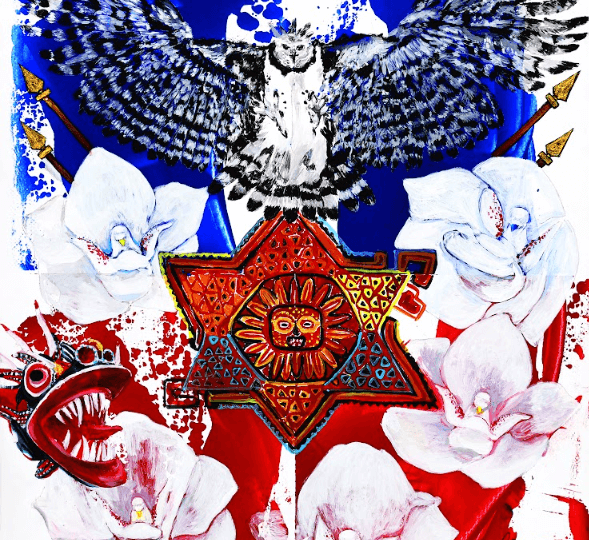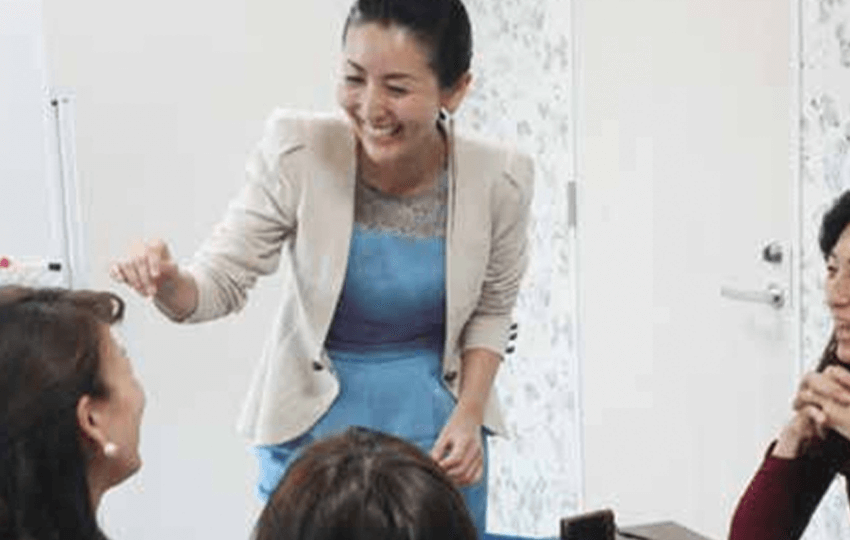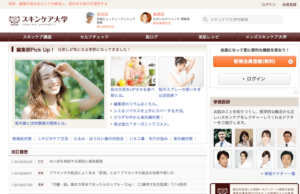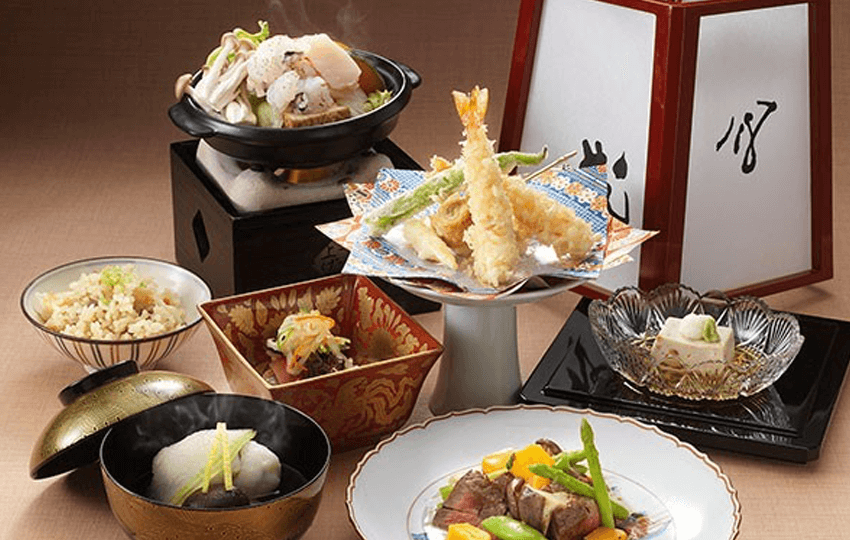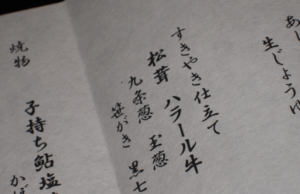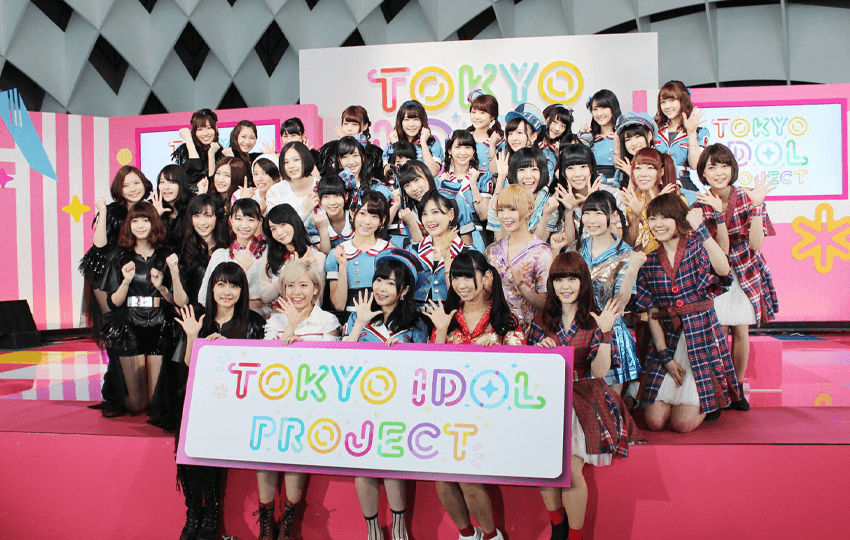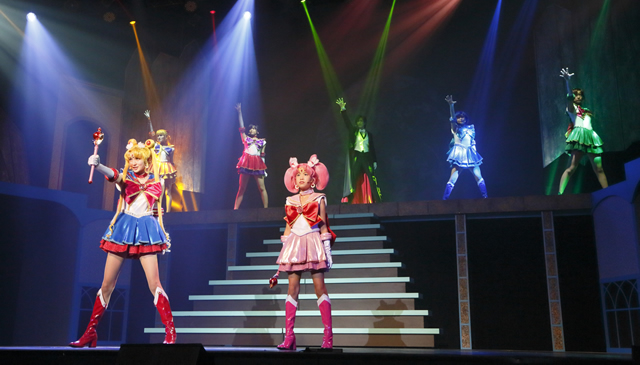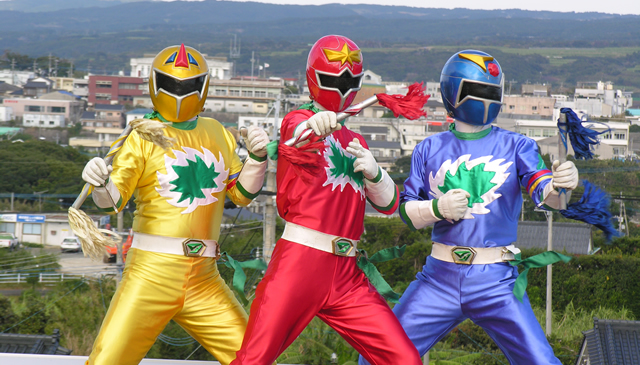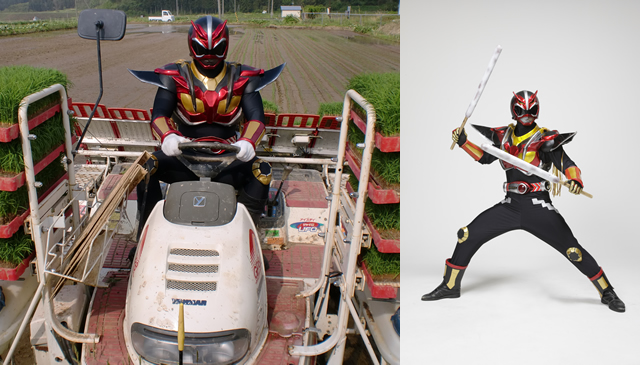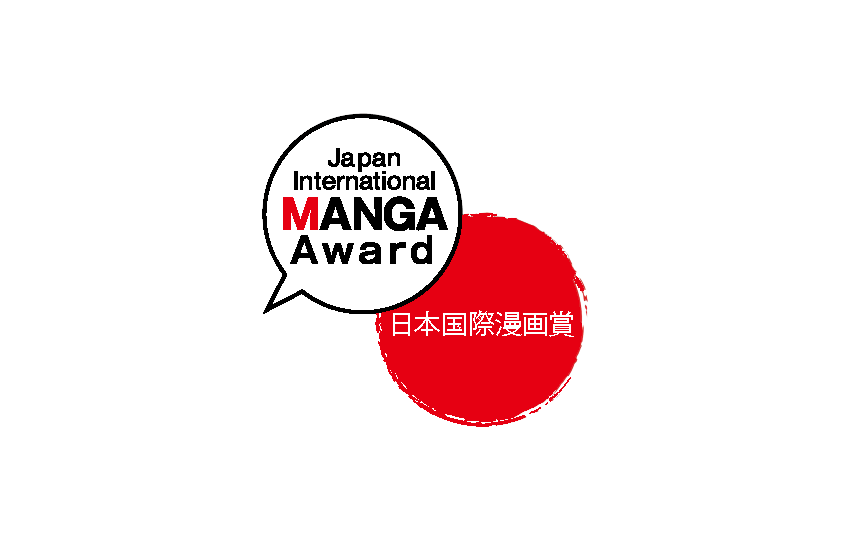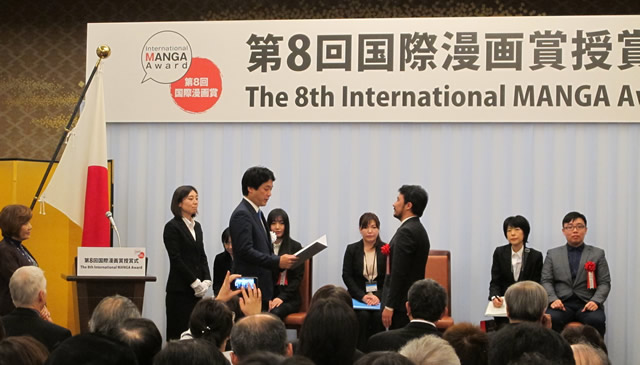-
The Canvas of Cultural Fusion: The Allure of Panama – 文化融合のキャンバス:パナマの魅力
[Hiragana Times EXPO – March 2024 issue]
In this Pavilion corner, vibrant artworks featuring the colors of Panama’s national flag, blue and red, are showcased.
今回のパビリオンは、パナマ共和国の国旗色[こっきしょく]、青と赤を基調に描かれた鮮やかな作品となりました。
The bird with spread wings represents Panama’s national bird, the Harpy Eagle, symbolizing independence and freedom. The ten shining stars above its head symbolize the unity of Panama’s ten provinces. In the center, there is a symbol of the sun and stars, inspired by the woven fabric“Mola”of the indigenous Kuna tribe, who worship nature.
翼を広げた鳥は、独立と自由を表すパナマの国鳥ハーピーイーグル(オウギワシ)。頭上に輝く10の星は、パナマ10州の結束を象徴しています。中央には、自然を崇拝する先住民クナ族の織物[おりもの]「モラ」からインスピレーションを受けて描かれた太陽と星のシンボル。
Surrounding it, Panama’s national flower, the“Espíritu Santo”or“Holy Spirit Orchid,” is characterized by its pure white petals with a dove seemingly perched at the center. In the background, numerous spears stand tall, symbolizing guarding peace and tranquility. Panama’s strength and purity coexist.
それを取り囲むパナマの国花エスピリトゥ・サント、別名「聖霊蘭[せいれいらん]」は、純白の花びらの中央に鳩が鎮座しているように見えるのが特徴です。背後には何本もの槍が平和と静寂を守るように力強く佇み、強靭と純粋が共存するパナマを示しています。
The annual“Carnival de Panama”showcases the rich diversity of Panamanian culture. During the early 20th-century construction of the Panama Canal, many Chinese laborers migrated to Panama. The timing of the carnival, which coincides with China’s Spring Festival (Lunar New Year), has led to the incorporation of Asian culture into the festivities. The Chinese lion dance depicted on the bottom left side represents this influence.
毎年盛大に開催される「カーニバル・デ・パナマ」には、パナマ文化の多様性が強く感じられます。20世紀初頭のパナマ運河建設時には、多くの中国人労働者がパナマに移住しました。そして、カーニバルの行われる時期が中国の春節[しゅんせつ](旧正月)に近いこともあり、カーニバルにはアジア文化も取り入れられています。下段左側に描かれている中国獅子舞がそれを表しています。
The fusion of tradition and culture, along with the generous spirit of the people, has created a remarkable masterpiece captured on a single canvas.
伝統と文化の融合、そして国民のおおらかな精神が、1枚のキャンバスに捉えられた見事な作品となりました。
-
[From August Issue 2015]
Following on from “rekijo” – women who like history – in recent years there are more and more “touken joshi,” that is women interested in swords. There are many kinds of swords in Japan. It’s said that this trend was kick-started by a video game. The swords in the game take the form of attractive young men and many women became fans for this reason.
The Tokugawa Art Museum, in Nagoya City, Aichi Prefecture, houses numerous famous swords. Up until now this museum used to mainly be visited by elderly men. But recently more and more women in their 20s and 30s are visiting the museum. “I think women have come to be fascinated by swords because they’ve entered pop culture through video games,” says YOSHIKAWA Yuki, a member of staff at the museum.
While swords are attractive artistic objects, besides their beauty, so-called famous swords also have historical tales behind them. For example, according to legend, “Katana Mei Muramasa” brought bad luck to the Tokugawa family; this sword has appeared in many games and novels and is popular nationwide. “The unique crest on the blade creates a mysterious mood and its charm draws you into its legend,” says Yoshikawa.
“I got into swords through video games and have discovered the charms of actual swords,” says NAKANE Tomoko, a sword fan. Nakane travels by night bus to visit museums all over Japan and see their swords. Sometimes she goes to the same museum three days in a row.
Besides their aesthetic charms, there are other ways to enjoy swords. As well as giving Skype-based “Samurai Experience Lessons” to American children, “Sousaku Kenbu Tachibana Ittouryu” runs “Samurai Training Tokyo,” a samurai workshop for foreigners visiting Japan.
“Sword Exercise” got started in 2008. Created by producer TAKAFUJI Ukon its key characteristic is that it gets you in shape through kenjutsu (swordsmanship) forms. Its popularity lies in the fact that in contrast to exercises that concentrate on developing muscles, it’s an easy to perform full body aerobic workout.
“I feel that the number people interested in swords has increased considerably,” says TSUNODA Tomohiro, the manager of Sword Exercise. While there has always been a high demand from men and from foreigners interested in swords for experience-based lessons, the number of female participants has increased tenfold since the start of the craze for swords amongst women.
The craze continues to spread as special displays in bookshops to sell new books on swords are set up and replicas of swords sell out. Who knows, perhaps more people will fall in love with swords in the future.
[2015年8月号掲載記事]
歴史好きな女性「歴女」に続き、最近は日本刀に興味を持つ「刀剣女子」が増えています。日本には様々な種類の刀があります。それに注目したゲームがブームのきっかけといわれています。ゲームの中では、刀は若い男性のアニメキャラクターの姿をしており、多くの女性がファンになりました。
愛知県名古屋市にある徳川美術館は、たくさんの名刀を所蔵しています。以前は美術館を訪問するのは年配の、それも男性が中心でした。ところが最近は20~30代の女性がグループで来館することが増えました。「刀剣の魅力を若い女性が知るようになったのはゲームというポップカルチャーの持つ力だと思います」と美術館職員の吉川由紀さんは言います。
刀剣は美しい芸術品ですが、名刀といわれる刀は美しさに加えて、歴史的な物語を持っています。例えば、全国的に人気のある「刀銘 村正」は徳川家に災いを呼ぶ刀という伝説があり、ゲームや小説などによく登場します。「独特の刃紋(刀に浮かぶ模様)はいかにも妖しい雰囲気を持ち、伝説に引き込まれるような魅力があります」と吉川さんは話します。
「刀に興味を持ったきっかけはゲームでしたが、刀そのものの魅力に気がつきました」と、刀剣ファンの中根智子さんは言います。中根さんは深夜バスに乗って、刀剣を鑑賞するために全国の美術館を訪れています。三日連続で同じ美術館に通うこともあります。
鑑賞の他にも、刀の魅力を楽しむ方法があります。「創作剣舞橘一刀流」は「SAMURAI TRAINING TOKYO」を訪日外国人向けに開催したり、アメリカの子ども向けにSkypeを使った「サムライ体験レッスン」を実施したりしています。
2008年からは「刀エクササイズ」を開催しています。剣術の型を取り入れシェイプアップできるのが大きな特徴で、プロデューサーのたかふじ右近さんが考案しました。筋肉トレーニングとは違い、全身を使った有酸素運動が無理なくできると好評です。
「刀剣に興味のある人がとても増えたことを実感します」と、マネージャーの角田知弘さんは言います。体験レッスンを希望する男性や刀に興味のある外国人はもともと多かったのですが、刀剣がブームとなってからは女性が10倍以上増えました。
刀関連の本が新たに発売されて特設コーナーが設けられたり、模造刀が品薄状態になったりとブームは広がっています。刀剣に魅了される人はこれからも増えるでしょう。文:土屋えみ
-
Tap Water in Japan is Safe to Drink
- Hiragana Times
- Jun 24, 2016
[From August Issue 2015]
Today, more than 97% of Japanese have access to the public water supply. The water supply is hardly ever cut off due to shortages. In general, no matter where you are in Japan, it’s possible to drink the tap water. However, although the Ministry of Health carries out 51 checks on water quality, some people install filters or buy mineral water.
In June, an event was held in eight locations in Tokyo to compare the taste of tap water with store bought mineral water. It was organized by the Tokyo Metropolitan Government Bureau of Waterworks. Passersby were asked to drink tap water and mineral water – both at a temperature of between 10°C to 15°C – without knowing which was which.
This wasn’t the first time this event had been held. During the fiscal year 2014 (April 2014 – March 2015), it was held 153 times and a total of 52,747 people took part. Forty six point seven percent of them answered, “Tap water tastes better.”
The 1960s was an era of rapid economic growth and even purified, tap water had a nasty smell because of pollution in rivers. Since at that time a lot of people were moving from regions with good quality water to metropolitan areas, there was a widespread perception that “tap water in large cities tastes bad”.
Since then the taste of tap water in large cities has improved due to developments in water purification technology and stricter controls on pollution. Some municipalities, such as Tokyo Prefecture are tackling the issue by setting “water quality targets.” YAMADA Tomoaki, PR manager at the Tokyo Metropolitan Government Bureau of Waterworks, says, “I’m glad when someone tells me, ‘I’ll drink tap water from now on since it tastes better.’”
To demonstrate the good taste of its tap water, the Tokyo Metropolitan Government Bureau of Waterworks distributes “Tokyo Water” in PET bottles at events. Other local governments, too, are selling and giving out PET bottles of their tap water to advertise its good taste and quality. Such water is sometimes handed out during natural disasters.
Japan’s waterworks is highly regarded: its pipes have few leaks, its water purification technology is high tech, and its equipment is well maintained. The government and some local authorities in Japan have, for many years, been offering technical cooperation to countries with poorly developed waterworks.
Bureau of Waterworks Tokyo Metropolitan Government
Text: SAZAKI Ryo[2015年8月号掲載記事]現在、日本の水道普及率は97パーセントを超えます。供給量が足りず断水が起きることはほとんどありません。通常どの地域であっても、蛇口から出てきた水を飲むことができます。厚生労働省が51の水質基準項目を定め管理していますが、浄水器をつける人やミネラルウォーターを買う人もいます。
6月に都内8カ所で、水道水と市販のミネラルウォーターのおいしさを比べるイベントが開かれました。東京都水道局が主催するもので、水道水とミネラルウォーターを、どちらも10~15度に温度を調整した上で、どちらがどちらか知らせずに道行く人に飲んでもらいました。
このイベントは、今回が初めてではありません。2014年度(2014年4月~2015年3月)にも153回、合計5万2,747人に行われ、46.7パーセントの人が「水道水の方がおいしい」と回答しました。
1960年代の高度経済成長期には河川が汚れ、浄水処理しても水道水にいやな臭いが残るようになりました。当時は水質のよい地方から都市部に移り住んだ人が多かったため、「都会の水道水はまずい」というイメージが広まりました。
その後は、公害対策が進んで河川の水質がよくなったことや、水を浄水処理する技術が進歩したことから、都市部の水道水の味は向上しました。東京都のように、「おいしさに関する水質目標」を独自に設定して、取り組みを進めている自治体もあります。東京都水道局広報係長の山田智章さんは、「『おいしいから今後は水道水を飲みます』と言っていただけるのが嬉しいですね」と話します。
東京都水道局では水道水のおいしさをアピールするため、ペットボトルに詰め、「東京水」と名づけてイベントで配布しています。他の自治体でも、おいしさや水質のプロモーションを目的に、ペットボトル入り水道水を販売したり配ったりしています。緊急時や災害時に支給されることもあります。
日本の水道は、水道管から水がもれる率が低い、浄水の技術が高い、設備のメンテナンスがよいなどの点で優れています。日本政府や自治体は、水道が未整備の国に対して長年技術協力をしています。
東京都水道局
文:砂崎良 -
[:ja][2015年7月号掲載記事]
ファンデーションなどの化粧品を使わず、すっぴん(素顔)で過ごしたいと考える女性が増えています。化粧で自分を飾ることより、美しい素肌を保つことのほうが大事という考えからです。
「女性の社会進出が進む一方、人間関係や仕事上でのトラブルなど精神的なストレスを抱えている人が多いと感じます」と、はちみつ美容研究家で株式会社アピココの東出佳子さんは言います。「ストレスは肌や健康状態に大きな悪影響を与えます。そんな中、女性達はファンデーションを塗らないことによって、心の開放感を得たいのかもしれません」と妹の東出直子さん。東出さん姉妹は、はちみつを使用した美容法を教える講座を開催しています。
東出さん姉妹は、近年の健康ブームもすっぴん人気と密接に関係していると言います。体と心の健康は肌の美しさと強く結びついています。「スキンケア大学」は、肌の調子を整えるための生活習慣やレシピ、スキンケア方法を紹介している情報サイトです。お肌や健康に関する情報はインターネット上にたくさんありますが、このサイトは医師や専門家が監修しているという信頼性の高さが人気です。
「すっぴんブームは素敵なことだと思います」と、スキンケア大学編集部の大竹空さんは言います。メイクをする必要があるときでも、その後に正しいスキンケアを行うことで、きれいな肌を保つことは可能です。「自分の肌に合った手入れを行うことが大事だといえるでしょう」。
「素肌をきれいに保とうとすると、必然的に健康的で規則正しい生活をするようになります」と利用している高尾真子さんは言います。喫煙や夜更かしなどの習慣をやめると、たった一週間で肌の調子が良くなったと実感する人は多いです。生活習慣を整える努力をすればするほど成果が目に見えてあらわれるのも、すっぴんブームの理由の一つなのかもしれません。
素肌を美しく保ちたいと考えるのは女性だけではありません。スキンケアにこだわる男性も増えています。アピココでは参加者の希望で、はちみつを使用した男性向けの美容講座も実施するようになりました。「はちみつ男子部」という、男性同士がスキンケアの情報交換をするコミュニティーもつくられています。
肌を美しく保つには、睡眠、運動、食生活などのライフスタイルに気を配る必要があります。他人に素顔を見せられるのは、自分のライフスタイルがきちんとしているという自信につながります。これからも自分を磨き、すっぴんで過ごす女性や、スキンケアに力を入れる男性は増えるかもしれません。文:土屋えみ[:en][From July Issue 2015]
More and more women want to spend time without makeup – such as foundation – on. The reasoning behind this trend is that it is better to maintain beautiful skin by leaving it bare, than to decorate it with makeup.
“While women continue to make great strides in the workplace, I feel that many are suffering from stress arising from their interpersonal relationships and job-related issues,” says HIGASHIDE Keiko, a honey beauty method researcher at Apikoko Co., Ltd. “Stress has a huge effect on your skin and on your health in general. With this in mind, it could be that women find it liberating to go without foundation,” says her younger sister HIGASHIDE Naoko. The Higashide sisters hold seminars to teach women a beauty method that utilizes honey.
The Higashide sisters say that the health boom in recent years is also closely related to the popularity of going makeup free. Physical and mental health is closely connected to the skin’s beauty.“Skincare University” is an Internet site that supplies visitors with information about beneficial habits, recipes, and skin care routines that keep the skin in good condition. In addition to providing a lot of information concerning skincare and health, this site is also popular for the reliability of its articles which are written under the editorial supervision of doctors and specialists.
“I think the makeup free boom is wonderful,” says OTAKE Sora, an editor at Skincare University. Even when you have to put on makeup, you can maintain beautiful skin by carrying out the correct skincare regime afterwards. “The important thing is to follow a treatment that suits your skin.”
“Keeping your skin clean inevitably leads to a healthy well-regulated lifestyle,” says TAKAO Mako, a regular visitor to the site. By cutting out habits like smoking and staying up late, many people feel that the condition of their skin improved after just one week. One of the reasons for the makeup free boom could be that the more effort you put into changing your habits, the better results you see.
It’s not only women that want to keep their skin beautiful. More and more men are also taking great pains over their skin. In response to demand from participants, Apikoko, has begun giving seminars to men about beauty routines that utilize honey. They have founded “Honey Men’s Club,” a community for men who want to swap information on skincare.
In order to maintain beautiful skin, you need to pay attention to your lifestyle and this includes how you sleep, exercise, and eat. It’s said that being able to show your bare face to others comes from the confidence gained from living right. Who knows, in the future more and more women into self-improvement may shun makeup and more and more men may put an effort into their skincare routines.Text: TSUCHIYA Emi[:]
-
More Places Offering Halal Food
- Hiragana Times
- May 10, 2016
[:ja][2015年6月号掲載記事]
日本にムスリム(イスラム教徒)はあまり多く住んでいません。しかし近年、ビジネスや観光目的で日本に来るムスリムが、特に東南アジアから増えています。そのため、イスラム教の戒律を守った食品「ハラルフード」の需要が増大しています。それにともなって、一般の日本人がハラルフードを口にする機会も増えつつあります。
ハラルフードの特徴は、豚肉、豚に由来する成分、アルコールを使っていないことです。その他、食肉をイスラム法の規定に従って処理していることなど細かい決まりがあります。イスラムの宗教団体によって認められるとハラル認証が下ります。ハラル認証は国や団体によって基準に違いがあります。日本では、非イスラム国であることを考慮した「ローカルハラル」、二大禁忌である豚と酒を避けた「ムスリムフレンドリー」などで認証をとるケースが一般的です。
2014年12月、東京・四谷にオープンしたカラオケ店「まねきねこ四谷三丁目店」は、カラオケだけでなく一般的な日本食と同じ調理のハラルフードが楽しめます。ハラ
ルフードは、イスラム法の規定を守っているという点以外は、一般的な食べ物と変わりません。四谷三丁目店には日本人も含む非ムスリムも多く来店します。お酒を飲むこともできます。お酒用の容器はハラルフードの食器とは別のシンクで洗われるなどの配慮がされていて、イスラム法の規定が守られています。
東京の新大久保には「イスラム横丁」と呼ばれる通りがあります。近くのビルの一室がモスク(イスラム教の礼拝所)になっているため、ムスリムが多く集まります。そのためこの通りやその付近にはハラルフードを売る店やレストランが増えました。ハラルフードを目当てに訪れる人の多くは外国人のムスリムですが、近年の日本ではエスニック料理が人気なので、エスニック料理の調味料などを求めて日本人もやってきます。
ムスリムの留学生が増えているため、大学でも学食にハラルフードのメニューを設けるようになりました。学食は学生以外の人も利用できるので、観光客や近所のビジネスマンなどが、ものめずらしさからハラルフードを注文する姿が見られます。
おもてなしの精神からハラルフードを導入する例もあります。京都にある江戸時代から続く料亭、美濃吉では、お客がお酒を口にしたくないならそれに対応するという考えから「ムスリムフレンドリーコース」をつくりました。豚肉はもともと使用していなかったため、調理でお酒を使わないだけでできました。
牛肉などはハラル対応の業者から購入し、包丁類はハラルと非ハラルの料理で分けています。現在では、ムスリムの取引先を接待する日本人ビジネスマンが同じメニューを口にするようになっています。文:砂崎良[:en][From June Issue 2015]
Not many Muslims (those who follow the Islamic faith) live in Japan. But the number of Muslim visitors – especially from South East Asia – to Japan for business or tourism has been on the rise in recent years. Demand for “Halal food” – food and drink prepared according to the precepts of the Islamic faith – is therefore increasing. Because of this tendency, there are increasing opportunities for non-Muslim Japanese to try Halal food.
Halal food contains no pork ingredients, nor any alcohol. Besides this, there are meticulous guidelines concerning, among other things, how meat should be treated. If an Islamic organization judges that the conditions are met, Halal certification is granted. Standards of Halal certification vary depending on the country and the organization. In Japan, most establishments get “local Halal” certification – which takes into consideration the fact that Japan isn’t a Muslim country – or “Muslim friendly” certification for not using the two taboo ingredients of pork and alcohol.
“Manekineko Yotsuya San-chome-ten” is a karaoke venue that opened in Yotsuya, Tokyo, in December 2014. It’s popular with Muslim tourists from abroad as they can not only enjoy karaoke, but also sample Halal Japanese food which is nevertheless prepared in the same way as typical Japanese food.
Halal food is different from non-Halal food only in that it’s prepared according to Islamic guidelines. Many non-Muslims, including Japanese, visit Yotsuya Sanchome-ten. It’s also possible to drink alcohol there if you want. Care is taken to follow to Islamic guidelines; for instance, tableware used for alcohol is washed in a different sink than tableware used for Halal food.
In Shin-Okubo, Tokyo, there’s a street called “Islam Yokocho.” Many Muslims gather there because a room in a nearby building is used as a mosque. Therefore, more and more shops and restaurants selling Halal food have appeared on this street. Although it’s mostly foreign Muslims who go there for Halal food, some Japanese also go to buy seasoning for ethnic cuisine – which is recently fashionable in Japan.
Some college cafeterias have introduced Halal dishes for the increasing number of Muslim students from abroad. Since these cafeterias are open to non-students, it’s possible to see tourists and local businessmen ordering Halal food out of curiosity.There are also cases where Halal food is served out of a spirit of hospitality. Minokichi, a Kyoto restaurant whose history dates back to the Edo era, has created a “Muslim-friendly Set Menu” for customers who don’t want to drink alcohol. Since the restaurant has never used pork, all it had to do was avoid using alcohol in its food preparation.
Minokichi buys beef and other ingredients from Halal distributors and uses separate cutlery for Halal food. Japanese businessmen today eat the same food as the Muslim clients they entertain.Text: SAZAKI Ryo[:]
-
Bringing Japanese Pop Culture to the World
- Hiragana Times
- May 10, 2016
[:ja][2015年6月号掲載記事]
TOKYO IDOL PROJECT
2015年3月、日本のアイドル文化を国内外へ発信する「TOKYO IDOL PROJECT」がスタートしました。フジテレビ、コンテンツ事業局アカウントプロデューサー、濵田俊也さんは記者会見で話しました。「アイドルの魅力をアイドルファンの方だけでなく一般の方にもお届けし、2020年の東京オリンピックに向けて日本と東京の盛り上がりをお手伝いしたいです」。
記者会見には、でんぱ組.inc、アイドリング!!!、ベイビーレイズJAPAN、Negicco、HKT48の5組のアイドルも出演して歌を披露しました。そして、「日本各地にすばらしいアイドルがたくさんいるということを伝えたい」「アイドルを通して日本のよさを知ってもらいたい」と抱負を語りました。
日本の芸能界では多くのアイドルが活躍しています。たいていは2人組から数十人の女の子または男の子のグループです。美しさや歌、ダンスのうまさより、かわいらしさや親しみやすさ、がんばっている様子が人気となる傾向があります。最近は、特定の商品や地域のPRを目的とするご当地アイドルも各地にいて、アイドルの活動はますます多彩になってきています。
日本のアイドルファンの特徴は、パフォーマンスを見るだけでなく、好きなアイドルがより有名になることやグループ内で昇格することを熱心に応援することです。そのため、ファンを対象とした握手会などのイベントには多くの人が集まり、テレビで生放送されるほど規模が大きくなることもあります。アイドルやそのファンが起こすムーブメントは日本のポップカルチャーの一つとなり、外国、特にアジアでも人気が高まっています。
TOKYO IDOL PROJECTは、このようなアイドル文化をより盛り上げるために始まりました。アイドルの活動や魅力をテレビ、ウェブ、雑誌、新聞、ラジオなどさまざまなメディアで伝えます。取り上げられるのは主に女性アイドルで、主要コンテンツは現在のところ4点です。
その一つ「TOKYO IDOL FESTIVAL」は2010年から行われている大規模なアイドルイベントです。2014年は138組のアイドルが出演し、4万人以上の観客が集まりました。今年は8月1日と2日に東京のお台場で開催されます。
TOKYO IDOL PROJECT LIVEはTOKYO IDOL PROJECTの基幹コンテンツで、毎月日本の各地で行われる予定です。TOKYO IDOL WEBは記事の掲載やライブの動画配信などを行う世界最大級のアイドルポータルサイトです。コラムニストによるアイドル論を載せるなどアイドルの再定義を目的としているのが特徴です。TOKYO IDOL PROJECT TVではTOKYO IDOL PROJECT LIVEの公演の様子やアイドルの最新情報などを伝えます。
TOKYO IDOL PROJECT [:en][From June Issue 2015]TOKYO IDOL PROJECT
In March 2015, the “TOKYO IDOL PROJECT” to promote Japan’s idol (pop star) culture in and outside Japan, was launched. HAMADA Shunya – who works as an account producer for the Content Division of Fuji TV – stated at a press conference for the event, “By communicating the appeal of idols, not just to their existing fans, but also to the general public, I hope to get the nation and Tokyo fired up about the Tokyo Olympics in 2020.”
Five groups of idols – Denpagumi. Inc., Idoling!!!, Babyraids JAPAN, Negicco and HKT48 – made an appearance at the same press conference to perform songs. They then talked about their ambition “to let people know Japan has wonderful idols in every region” and “to help the world discover positive aspects of Japan through us idols.”
A large number of idols are active in Japan’s entertainment business. Most are all female or all male groups with two to a few dozen members. As a rule, their popularity is based not on their beauty, nor on their singing and dancing abilities, but on their cuteness, friendliness, and dedication. Nowadays, idols have branched out into different fields; for instance there are also so-called local idols whose role is to advertise a particular product or region.
Typically, Japanese fans not only watch their favorite idol’s performance but also root enthusiastically for them to become more famous, or for their status to rise within the group. That’s why many people attend fan events such as meet-and-greet sessions. Some of these events are large enough to be broadcast live on TV. Idols and the movements spawned by their fans have become part of Japan’s pop culture and their popularity is on the rise overseas, more particularly in Asia.
The TOKYO IDOL PROJECT was launched to further promote this idol culture. It broadcasts details of the idols’ activities and charms through various media, including television, the web, magazines, newspapers, and radio. It’s mostly female idols that are covered and at the time of writing, there are four main points through which the campaign is run.
The TOKYO IDOL FESTIVAL is one of these projects and is a large scale event that has been held since 2010. In 2014, 138 groups of idols performed and more than 40,000 spectators attended. This year it’ll be held on August 1 and 2 at Odaiba, Tokyo.
TOKYO IDOL PROJECT LIVE is the main vehicle for TOKYO IDOL PROJECT and will be held every month in different parts of Japan. TOKYO IDOL WEB is one of the world’s largest idol websites offering, among other things, articles, and videos of lives shows. The website is unusual in that it aims to redefine idols by publishing essays about idols by its columnists. TOKYO IDOL PROJECT TV broadcasts clips from concerts and provides up-to-date information about idols.
TOKYO IDOL PROJECT [:] -
2.5-Dimensional Musicals
In March, 2015, AiiA 2.5 Theater Tokyo opened in Shibuya, Tokyo. It is the world’s first theater dedicated to “2.5-Dimensional Musicals,” that is theatrical productions based on manga, anime, and video game titles that faithfully recreate the original’s atmosphere and characters.
Recently 2.5-Dimensional theatrical productions are increasingly being staged in Japan and audience numbers are growing too. In 2013, about 1,600,000 people attended a 2.5-Dimensional performance. In 2014, the Japan 2.5-Dimensional Musical Association Secretariat was established and began its activities, performing tasks such as compiling and sending out information on all performances both within and outside Japan. The association also opened the dedicated theatre.
There is an English page on the association’s official website, and it’s possible to purchase tickets from outside Japan. In addition, subtitles are available through a wearable terminal at the theatre. Audiences can choose from a maximum of four optional languages, though the subtitle languages available do change depending on the performance.
“When the popular musical ‘Pretty Guardian Sailor Moon: The Musical,’ was staged, 20 to 30 percent of the audience was from outside Japan. When this dedicated theatre was opened, in the hopes of getting more foreigners to see our shows, we installed a subtitle system,” says TODA Naomi, head of PR. “Since it is wearable, it’s possible to read the subtitles without taking your eyes off the actors.”
In Japan, in 1974, works like “The Rose of Versailles” were adapted into musicals, since then there have been theatrical productions of original manga and anime. “There is a long history of manga and anime being adapted into theatrical productions. But the genre only started to gain wider recognition when the ‘MUSICAL THE PRINCE OF TENNIS’ was staged in 2003,” says Toda.
This musical was well-received by fans of the manga, for its skillful recreation of the original work’s atmosphere. It also went down well with theatrical fans for the production effect of showing the movement of a ball with a spotlight. “It was a good example of how the world of manga could be successfully adapted for the stage,” says Toda. As the appreciation of both manga and anime rose at home and abroad, the number of adaptations that stayed faithful to the original increased. This resulted in the birth of the so-called “2.5-Dimensional” genre.
“Rather than mimicking characters, actors play these parts by trying not to undermine the image of the characters in the original work. The director also does his best to recreate the world shown in the original work on the stage. And that’s why the audience’s imaginations are stimulated to fill in the blanks, thus enabling them to visualize the original work on the stage,” says Toda. The 2.5-Dimensional Musical, “Live Spectacle NARUTO” is scheduled to be staged in Macao, Malaysia, and Singapore. Plans to promote this genre to the overseas market are advancing.
The Japan 2.5-Dimensional Musicals Association Secretariat2015年3月、東京・渋谷にアイア2.5シアタートーキョーがオープンしました。ここは、まんがやアニメ、ゲームを原作としていて、原作の雰囲気やキャラクターを忠実に再現する「2.5次元ミュージカル」を専門に上演する世界初の劇場です。
2.5次元の舞台芸術は近年日本で上演が増えていて、観客の数も増加しています。2013年には約160万人以上の人が観劇しました。2014年には日本2.5次元ミュージカル協会が設立され、各公演情報を一括して国内外に発信するなどの活動を始めました。専用劇場のオープンもこの協会によるものです。
協会の公式サイトには英語のページもあり、海外からもチケットを買うことができます。また、劇場にはウェアラブル端末による字幕システムが用意されています。公演によって字幕言語は変わりますが最大4ヵ国語が設定でき、観客はその中から選ぶことができます。
「人気のミュージカル『美少女戦士セーラームーン』を公演した際、すでに2~3割のお客様が外国の方でした。専用劇場のオープンにより、もっと多くの外国の方に舞台を見ていただきたいと思い、字幕システムの導入を進めました」と協会の広報を担当する遠田尚美さんは言います。「ウェアラブルなので役者から目を離さずに字幕をお読みいただけます」。
日本では1974年に「ベルサイユのばら」がミュージカル化されるなど、まんがやアニメを原作とした舞台芸術は以前からありました。「まんがやアニメを原作とした舞台芸術の歴史は意外と古いのです。でも、このジャンルの舞台芸術が認知され始めたのは2003年に上演されたミュージカル『テニスの王子様』といえます」と遠田さん。
この作品は原作の雰囲気を巧みに表現してまんがファンに歓迎されました。球の動きをスポットライトで表現するなどの演出は演劇ファンにも好評でした。「まんがの世界を舞台上に表現するための『変換』がうまくいった良い例でした」と遠田さん。国内外においてまんがやアニメに対する評価が上がったこともあり、原作らしさを追求した作品が増えました。そして「2.5次元」という呼び方が生まれました。
「役者は原作のキャラクターをまねするというよりも、そのキャラクターの持つイメージを損なうことなく演じ、演出家も原作の世界観を舞台上に再現します。だからこそ観客は想像力を刺激され、欠けている部分を空想で補って原作そのもののシーンを舞台上に見るのです」と遠田さん。2.5次元ミュージカルは、「ライブ・スペクタクル NARUTO -ナルト-」がマカオ、マレーシア、シンガポールでも上演されるなど、今後は積極的な海外進出も予定されています。
一般社団法人日本2.5次元ミュージカル協会
文:砂崎良 -
Local Heroes Born From Love of Home Towns
- Hiragana Times
- Dec 15, 2015
[From April Issue 2015]
Heroic characters that come to the aid of the weak and slay evil are well-liked in Japan. Many Japanese grow up watching TV programs about such heroes. Each region has its local mascot and the number of heroic characters, too, is increasing. These are called local heroes.
Local mascots are created to promote local produce or to revitalize their region. However, most local heroes come into being because of the locals’ affection for their region or from their longing for a heroic character. It’s said that as many as 700 heroic characters exist in Japan. They are popular not only with children, but also with grownups.
On Tanegashima Island in Kagoshima Prefecture, “Rito Shentai Tanegashiman” is popular. This team of heroes were created 17 years ago by a local youth club. Speaking the local dialect, rather than fighting like heroes, their role is to inspire the people of Tanegashima. The Tanegashiman team is already renowned not only in Kagoshima but in other prefectures. “I’d like everyone in the country to know about Tanegashima and Tanegashiman,” says KUKIHARA Kiyotaka of the PR department of Tanegashima Action Club.
Tanegashiman get a lot of requests to appear at long-distance relay races and, being well-received by the elderly, at local class reunions for 60-year-olds. To the surprise of the youth club’s members, their villainous enemies, the Jabatche, have also become popular. The Jabatche speak the Tanegashima dialect and make people laugh with jokes about audience members. Their amusing banter with the audience is the talk of the town.
Chojin Neiger
The local hero of Akita Prefecture, too, is also massively popular. Super God Neiger was inspired by the well-known cry of Akita’s local deity Namahage “Warui ko wa ‘ineiger’/inai ka.” (Are there any naughty children here?) His true identity is AKITA Ken., a young man from an ordinary family of farmers. He protects the peace from baddies. When he transforms into Neiger his rallying cry is “Super God Neiger, protector of the sea, the mountains and Akita!”
EBINA Tamotsu, who was instrumental in the creation of Super God Neiger, has loved heroic characters since his childhood. He believes Neiger’s popularity is in the way that the hero embraces the Akita world. A TV program about Neiger was broadcast not only in Akita, but also in Tokyo. “Nothing makes me happier than hearing children cheering,” says Ebina.
Local heroes might utilize regional products as weapons or have a signature pose. TAKAMOTO Shintaro is a fan of local heroes and even travels to distant locations for meet-and-greet events and shows. “I find it particularly interesting that they speak in dialects. It’s also fun to compare regional idiosyncrasies,” he says.
Most heroes fight their enemies in order to keep the peace and protect the environment in their regions. They therefore set a good example to children. Some adults are nostalgic for the heroes they once looked up to. Local heroes will continue to serve locals’ affection for their region.Text: TSUCHIYA Emi[2015年4月号掲載記事]
弱い人を助け、悪を退治するヒーローキャラクターが日本で人気です。多くの日本人がそんなヒーローのテレビ番組を見て育ちました。各地にはご当地キャラクターがいますが、ヒーローのキャラクターも増えています。彼らはご当地ヒーローと呼ばれています。
ご当地キャラはその地方の名産品の宣伝や、地域を活性化する目的でつくられます。一方、ご当地ヒーローは地元の人のふるさとへの愛情や、ヒーローへの憧れから生まれることが多いです。今では日本全国に700ものヒーローキャラクターが存在するといわれています。子どもだけでなく大人にも人気があります。
鹿児島県の種子島では、「離島閃隊タネガシマン」が人気です。17年前に地元の青年団が考え出しました。種子島の方言を話し、戦うヒーローというよりも種子島に閃きを与える役割を担っています。今では鹿児島だけでなく他の県でも知られるようになりました。「全国の人に種子島とタネガシマンについて知ってほしいです」と種子島アクションクラブ広報部の久木原清貴さんは話します。
駅伝大会や地元の還暦同窓会などへの出演依頼が多く、お年寄りにも歓迎されています。青年団の人たちにとって意外だったのは、タネガシマンだけでなくジャバッチェという悪役にも人気が出たことです。ジャバッチェは種子島の方言を話し、お客さんをネタにして笑いをとります。そのやりとりが面白いと評判になりました。秋田県にも大人気のご当地ヒーローがいます。有名な秋田の神様、なまはげの叫び声「悪い子はいねが(悪い子はいないか)」にちなんだ「超神ネイガー」です。その実体はごく普通の農家の青年、アキタ・ケンです。彼は悪者から平和を守ります。変身のときの決め台詞は「海を、山を、秋田を守る、超神ネイガー!」です。
超神ネイガーの生みの親、海老名保さんは子どもの頃からヒーローキャラクターが大好きでした。ヒーローものに秋田の世界を取り入れたことが人気の理由と考えています。テレビ番組は秋田だけでなく東京でも放送されました。「子どもたちの声援が何よりもうれしいです」と海老名さんは言います。
ご当地ヒーローはその地域の特産物を武器にしたり決めのポーズに取り入れたりしています。ご当地ヒーローファンの高本新太郎さんは握手会やショーのため遠方にも足を運びます。「方言でしゃべるところが特におもしろいです。地域の個性が出ているので比較する楽しみもあります」と言います。
多くのヒーローは地域の安全や自然保護のために敵と戦います。そのため、子どもたちにとってよいお手本となっています。また、大人の中には昔憧れたヒーローを懐かしく思い出す人も多いのです。これからもご当地ヒーローは地元の人の郷土愛に貢献していくでしょう。文:土屋えみ
-
[From April Issue 2015]

In February 2015, the awards ceremony for the Eighth International Manga Awards was held in Minato City, Tokyo Prefecture. It’s an open contest for manga created outside Japan. It’s organized by Japan’s Ministry of Foreign Affairs and the Japan Foundation – a cultural organization specializing in international cultural exchanges and Japanese language education. The Japan Cartoonists’ Association and publishers of manga magazines are also involved. This time, 317 works from 46 countries/regions were submitted and 15 of them won awards. The award winning works from Asia, the West, the Middle East and Africa reflected the continuing expansion and development of manga culture.
Gold and Silver Award winners are invited to Japan to meet Japanese cartoonists and to visit publishers and other manga-related sites. This year’s Gold Award was given to Nambaral ERDENEBAYAR from Mongolia. Luo mu from China, Ben WONG from Malaysia, and 61Chi from Taiwan were selected for the Silver Award. Though 61Chi had a prior engagement, the other three winners came to Japan.
“Bumbardai,” Erdenebayar’s award winning work, depicts the close relationship of a nomadic mother and child. “I want to continue depicting the traditional life of nomads. I’d also like to explore the subject of Mongolian folklore,” says Erdenebayar. “I loved Doraemon as a child. I went to the Fujiko・F・Fujio Museum during this stay in Japan and it was like a dream come true.”
Luo mu, who won her award for “Mr. Bear,” a story about a boy in a bear costume, has been drawing manga for only a year or two. “I’m still quite inexperienced when it comes to drawing manga and constructing stories, so I was both surprised and delighted when I learned about the award,” she says. “I’ll continue to do my best now that I’ve been commissioned to do a series. I’d like to create heart-warming works in the future.”
Ben Wong who won his award for “Atan,” a story about a boy and a water buffalo, is a talented cartoonist who’d already won an award at the first International Manga Awards. “I became a manga writer because I thought it was a good business opportunity. My entrepreneurial spirit was stimulated by the possibility of success and by the risks involved,” he says. “From now on, I’d like to expand into educational manga,” he said about his ambitions for the future.
“There was a time when it was said that Japanese manga wasn’t up to world standards. Japanese cartoonists, however, instead of trying to adapt to this, only depicted what would please readers,” said cartoonist SATONAKA Machiko, chief judge. “In whichever country manga is drawn, readers will welcome it as long as it’s fun. And by sharing stories, we get to know about each other’s cultures,” she said, giving words of encouragement to the winners.
“The level of the art work was so high and the stories were so well constructed that these works might as well have been published in Japan,” says SAITO Yuko from the Cultural Affairs and Overseas Public Relations Division of the Ministry of Foreign Affairs. “I hope these awards will one day be loved by cartoonists and readers throughout the whole world.” The application period for the next International Manga Award is expected to be from mid-April to late May.
International Manga Award
Text: SAZAKI Ryo[2015年4月号掲載記事]2015年2月、東京都港区で第8回国際漫画賞の授賞式が行われました。この賞は公募制で、日本国外で制作されたまんがを対象にしています。日本の外務省と海外の文化交流や日本語教育を行っている文化団体の国際交流基金が主催。日本漫画家協会やまんが雑誌を発行している出版社なども協力しています。今回は46の国と地域から317作品が集まり、15作品に賞が与えられました。受賞作にはアジア、欧米、中東、アフリカの作品があり、まんが文化の広がりと発展が感じられました。
最優秀賞と優秀賞の受賞者は日本に招待され、日本の漫画家と交流したり、出版社やまんがに関わりのある場所を訪問したりします。今回の最優秀賞はモンゴルのナンバラル・エルデネバヤルさんに贈られました。優秀賞には中国の落木さん、マレーシアのベン・ウォンさん、台湾の61Chiさんが選ばれ、都合のつかなかった61Chiさんを除く3名が来日しました。
エルデネバヤルさんの受賞作品「ボンバルダイ」は、遊牧民の生活を通して母と子の絆を描いたものです。「これからも遊牧民の伝統的な生活を描きたいです。モンゴルの民話も題材にしたいですね」とエルデネバヤルさん。「子どもの頃、ドラえもんが大好きでした。今回の来日で藤子・F・不二雄ミュージアムに行けて夢のようです」。
クマの着ぐるみを着た少年の話「クマさん」で受賞した落木さんは、まんがを描き始めてまだ1、2年です。「まんがの描き方もストーリーの作り方もまだまだ未熟ですので、受賞を知ったときにはとても驚き、同時に嬉しかったです」と言います。「新しい作品の連載も決まったのでがんばりたいです。心温まる作品を描いていきたいですね」。
少年と水牛の物語「アタン」で受賞したベン・ウォンさんは、第1回国際漫画賞でも受賞した実力者です。「私が漫画家になったのは、ビジネスチャンスがあると思ったからです。リスキーですが成功も狙える点にベンチャー精神を刺激されました」と言います。「今後は、教育まんがにも手を広げていきたいですね」と抱負を語ります。
「日本のまんがは世界のスタンダードに合っていないと言われた時代もありました。でも日本の漫画家たちはそれに合わせようとはせず、読者が面白いと思うものだけを描いてきました」と漫画家の里中満智子審査委員長は述べました。「どこの国の人が描いたまんがでも、面白ければ読者は受け入れます。そして物語を共有することで、私たちはお互いの文化を知ることができます」と受賞者を激励しました。
「どの作品も、日本で発表されてもおかしくないと思うほど絵のレベルが高く、ストーリーも巧みでした」と外務省文化交流・海外広報課の齋藤有子さんは言います。「この賞が世界中の漫画家や読者に愛される賞になるといいですね」。次回の国際漫画賞の募集期間は4月中旬から5月末の予定です。
国際漫画賞
文:砂崎良 -
Popular TV Programs Allow Foreigners to See Their Countries Through Japanese Eyes and Vice Versa
- Hiragana Times
- Nov 06, 2015
[From March Issue 2015]
Broadcasting a variety of programs 24 hours a day, 365 days a year, in Japan there are numerous TV stations and this includes one public channel, five major private TV channels, local stations, BS, and CS. Among the programs broadcast, there are many that feature foreign countries and non-Japanese people. Those introducing the lives of Japanese living overseas and the lives of non-Japanese in Japan are popular.
In “Far Away Neighbours” celebrities drop in on Japanese living in places rarely visited by ordinary Japanese citizens. This series, broadcast on the TV Asahi channel and its network, is mainly hosted by the Chihara Brothers comic double act. The appeal of this program as a documentary is its portrayal of visiting celebrities grappling with riding small busses and trying to make the right connections in order to reach their destination, as well as the way it introduces the real lives of local people.
Since many of the people visited are the only Japanese in the area, they cannot rely on the embassy or local Japanese communities and have had to solve problems on their own. In most cases, being far from Japan means that life can be rather inconvenient. The ups and downs of their lives up until the present day and their courage in overcoming these difficulties are highlighted in the show.
Broadcast by the TBS network, “The World’s Japa-zuma” is a program that features the lives of Japanese women who have married non-Japanese men and are living overseas. When it’s revealed how these woman came to move overseas for marriage, the footage is discussed in the studio by celebrities and non-Japanese women living in Japan. The hosts are the comic duo Bakusho Mondai.
One of the highlights of the program is in its detailed portrayal of the individual lives of these women, the difficulties they face in foreign countries and the cultural differences between them and their husbands. For instance, a woman who moved to New Zealand won sympathy of viewers because of the way she took care of her children while running a ranch with her husband. Her practically self-sufficient lifestyle stirred up feelings of curiosity and admiration in viewers.
“Why did you come to Japan?” is broadcast by the TV Tokyo network. To discover why people come to Japan, foreigners are interviewed at Narita International Airport. Sometimes, their special skills are introduced, as in the case of people who came to Japan to participate in a karate event. The individual responses of people coming from overseas and the variety of reasons for coming to Japan stir up the viewer’s interest.
In some cases, the coverage of people interviewed at the airport continues. A couple of Danish men appeared numerous times in the program because of their unique style of traveling which involved choosing a destination by blindfolding themselves and pointing at random to an open guidebook. The show is surprising to viewers because foreigners want to visit unusual places or even places Japanese people don’t know about. The witty commentary by the show’s hosts, comic due Bananaman, is also popular.Text: SAZAKI Ryo[2015年3月号掲載記事]
日本には、1局の公共放送と5局のメジャー民間放送、地方局、BS、CSなど多くのテレビ局があり、24時間365日、さまざまな番組が放送されています。その中には外国や外国人を取りあげている番組がたくさんあります。中でも外国で暮らす日本人の生活をテーマとしたものや、日本に来た外国人を紹介する番組が人気です。
「世界の村で発見!こんなところに日本人」は、一般的な日本人が通常行かない土地で暮らしている日本人を芸能人が訪問する番組です。主な出演者は、お笑い芸人コンビである千原兄弟で、テレビ朝日系列で放映されています。訪問する芸能人が外国で小さな乗り合いバスを苦労して探し乗り継いでいく様子や、観光地ではない町が取り上げられ、現地の人の生活ぶりが紹介されるところにドキュメンタリーとしての面白さがあります。
この番組で取り上げられる人は、その地域で唯一の日本人であるケースが多いため、問題が生じても大使館や現地の日本人コミュニティーなどを頼ることができず、自力で解決しなければなりません。たいていの場合、日本よりはるかに不便な生活です。今日に至るまでの波瀾万丈の人生や、困難を乗り越えてきたたくましさが見どころです。
「世界の日本人妻は見た!」は、外国人と結婚して海外で暮らす日本人女性の生活を紹介する番組です。TBS系列で放映されています。その日本人女性が海外へ嫁ぐに至った経緯や、現在の暮らしぶりが紹介された後、スタジオで芸能人や日本在住の外国人女性などがその内容について話し合います。司会はお笑い芸人コンビ、爆笑問題です。
この番組の見どころの一つは、女性の個性的な生き方や海外生活の苦労、配偶者との文化ギャップなどが細かく伝えられることです。例えば、ニュージーランドへ移住した女性のケースでは、夫と二人で牧場を経営しながら子育てに奮闘する姿が視聴者の共感を得ました。自給自足が中心の生活は珍しさとあこがれを感じさせます。
「YOUは何しに日本へ?」は、テレビ東京系列で放映されている番組です。成田国際空港などで外国人に「YOUは何しに日本へ?」と、日本に来た目的を聞きます。空手の大会に出るために来日した人には技を見せてもらうなど、その人の特技が披露されることもあります。来日した人の個性ゆたかな反応や、さまざまな来日理由が視聴者の関心をそそります。
空港でインタビューした人を取材し続けるケースもあります。あるデンマーク人男性の二人組は目隠しして旅行ガイドを開き、指差したところへ行くという旅行スタイルがユニークだったため、何回もこの番組に取り上げられています。外国人が日本で行きたがるところは、日本人にとっては珍しくなかったり未知の場所だったりするため、視聴者にとっては新鮮です。司会を務めるお笑い芸人コンビ、バナナマンのトークも人気です。文:砂崎良
Information From Hiragana Times
-
 February 2026 Issue
January 21, 2026
February 2026 Issue
January 21, 2026 -
 January 2026 Issue – Available as a Back Issue
January 15, 2026
January 2026 Issue – Available as a Back Issue
January 15, 2026 -
 December 2025 Issue —Available as a Back Issue
November 20, 2025
December 2025 Issue —Available as a Back Issue
November 20, 2025

